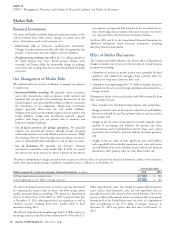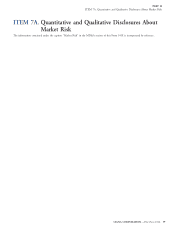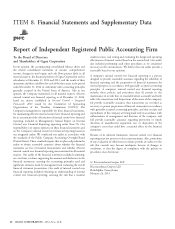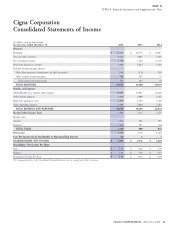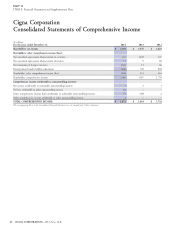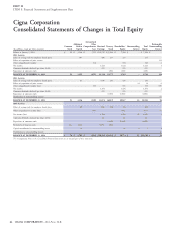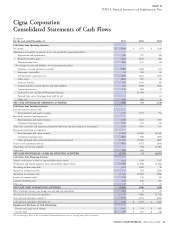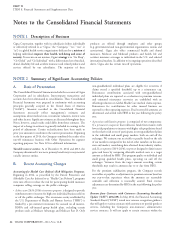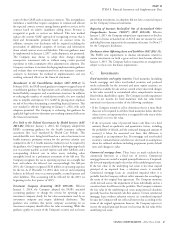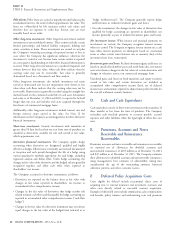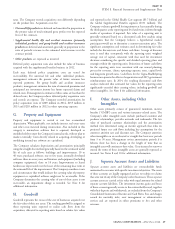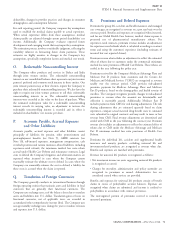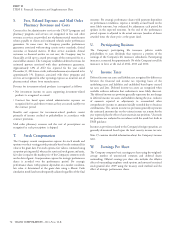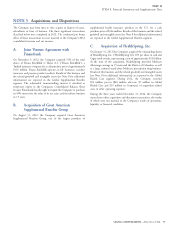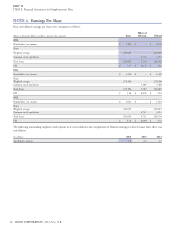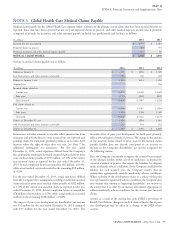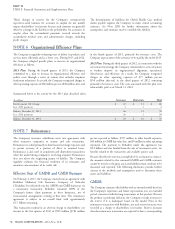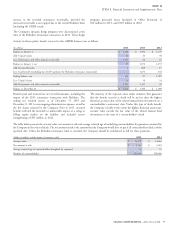Cigna 2014 Annual Report Download - page 100
Download and view the complete annual report
Please find page 100 of the 2014 Cigna annual report below. You can navigate through the pages in the report by either clicking on the pages listed below, or by using the keyword search tool below to find specific information within the annual report.PART II
ITEM 8. Financial Statements and Supplementary Data
Policy loans. Policy loans are carried at unpaid principal balances plus ‘‘hedge ineffectiveness’’). The Company generally reports hedge
accumulated interest, the total of which approximates fair value. The ineffectiveness in realized investment gains and losses.
loans are collateralized by life insurance policy cash values and On early termination, the changes in fair value of derivatives that
therefore have no exposure to credit loss. Interest rates are reset qualified for hedge accounting are reported in shareholders’ net
annually based on an index. income (generally as part of realized investment gains and losses).
Other long-term investments. Other long-term investments include Net investment income. When interest and principal payments on
investments in unconsolidated entities. These entities include certain investments are current, the Company recognizes interest income
limited partnerships and limited liability companies holding real when it is earned. The Company recognizes interest income on a cash
estate, securities or loans. These investments are carried at cost plus basis when interest payments are delinquent based on contractual
the Company’s ownership percentage of reported income or loss in terms or when certain terms (interest rate or maturity date) of the
cases where the Company has significant influence, otherwise the investment have been restructured.
investment is carried at cost. Income from certain entities is reported
on a one quarter lag depending on when their financial information is Investment gains and losses. Realized investment gains and losses are
received. Other long-term investments are considered impaired, and based on specifically identified assets and result from sales, investment
written down to their fair value, when cash flows indicate that the asset write-downs, changes in the fair values of certain derivatives and
carrying value may not be recoverable. Fair value is generally changes in valuation reserves on commercial mortgage loans.
determined based on a discounted cash flow analysis. Unrealized gains and losses on fixed maturities and equity securities
Other long-term investments also include investment real estate carried at fair value and certain derivatives are included in
carried at depreciated cost less any impairment write downs to fair accumulated other comprehensive income (loss), net of deferred
value when cash flows indicate that the carrying value may not be income taxes and amounts required to adjust future policy benefits for
recoverable. Depreciation is generally recorded using the straight-line the run-off settlement annuity business.
method based on the estimated useful life of each asset. Investment
real estate as of December 31, 2014 and 2013 is expected to be held
D. Cash and Cash Equivalents
longer than one year and includes real estate acquired through the
foreclosure of commercial mortgage loans. Cash equivalents consist of short-term investments with maturities of
Additionally, other long-term investments include interest rate and three months or less from the time of purchase. The Company
foreign currency swaps carried at fair value. See Note 12 for reclassifies cash overdraft positions to accounts payable, accrued
information on the Company’s accounting policies for these derivative expenses and other liabilities when the legal right of offset does not
financial instruments. exist.
Short-term investments. Security investments with maturities of
greater than 90 days but less than one year from time of purchase are
E. Premiums, Accounts and Notes
classified as short-term, available for sale and carried at fair value,
Receivable and Reinsurance
which approximates cost.
Recoverables
Derivative financial instruments. The Company applies hedge Premiums, accounts and notes receivable and reinsurance recoverables
accounting when derivatives are designated, qualified and highly are reported net of allowances for doubtful accounts and
effective as hedges. Effectiveness is formally assessed and documented unrecoverable reinsurance of $105 million as of December 31, 2014
at inception and each period throughout the life of a hedge using and $47 million as of December 31, 2013. The Company estimates
various quantitative methods appropriate for each hedge, including these allowances for doubtful accounts and unrecoverable reinsurance
regression analysis and dollar offset. Under hedge accounting, the using management’s best estimates of collectability, taking into
changes in fair value of the derivative and the hedged risk are generally consideration the age of the outstanding amounts, historical
recognized together and offset each other when reported in collection patterns and other economic factors.
shareholders’ net income.
The Company accounts for derivative instruments as follows:
F. Deferred Policy Acquisition Costs
Derivatives are reported on the balance sheet at fair value with Costs eligible for deferral include incremental, direct costs of
changes in fair values reported in shareholders’ net income or acquiring new or renewal insurance and investment contracts and
accumulated other comprehensive income. other costs directly related to successful contract acquisition.
Changes in the fair value of derivatives that hedge market risk Examples of deferrable costs include commissions, sales compensation
related to future cash flows and that qualify for hedge accounting are and benefits, policy issuance and underwriting costs and premium
reported in accumulated other comprehensive income (‘‘cash flow
hedges’’).
Changes in the fair value of a derivative instrument may not always
equal changes in the fair value of the hedged item (referred to as
68 CIGNA CORPORATION - 2014 Form 10-K
•
•
•
•


